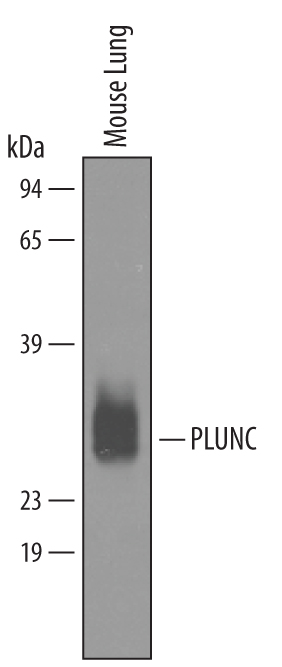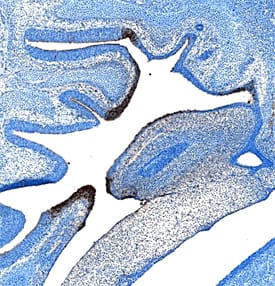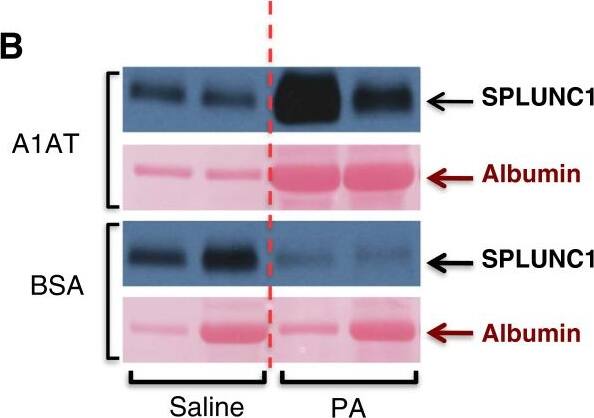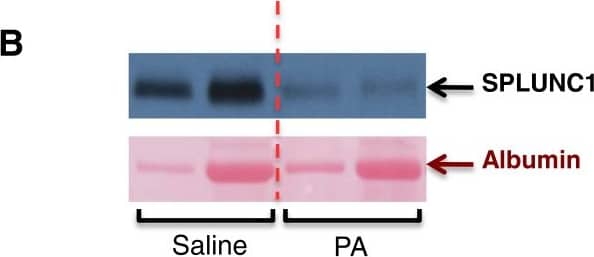Mouse PLUNC Antibody Summary
Ala59-Val278
Accession # NP_035256
Applications
Please Note: Optimal dilutions should be determined by each laboratory for each application. General Protocols are available in the Technical Information section on our website.
Scientific Data
 View Larger
View Larger
Detection of Mouse PLUNC by Western Blot. Western blot shows lysates of mouse lung tissue. PVDF membrane was probed with 1 µg/mL of Sheep Anti-Mouse PLUNC Antigen Affinity-purified Polyclonal Antibody (Catalog # AF4274) followed by HRP-conjugated Anti-Sheep IgG Secondary Antibody (Catalog # HAF016). A specific band was detected for PLUNC at approximately 30kDa (as indicated). This experiment was conducted under reducing conditions and using Immunoblot Buffer Group 8.
 View Larger
View Larger
PLUNC in Mouse Embryo. PLUNC was detected in immersion fixed frozen sections of mouse embryo nose (13 d.p.c.) using Sheep Anti-Mouse PLUNC Antigen Affinity-purified Polyclonal Antibody (Catalog # AF4274) at 1.7 µg/mL overnight at 4 °C. Tissue was stained using the Anti-Sheep HRP-DAB Cell & Tissue Staining Kit (brown; Catalog # CTS019) and counterstained with hematoxylin (blue). Specific staining was localized to olfactory epithelium. View our protocol for Chromogenic IHC Staining of Frozen Tissue Sections.
 View Larger
View Larger
Detection of Mouse PLUNC by Western Blot A1AT treatment enhances SPLUNC1 and reduces NE activity in bronchoalveolar lavage (BAL) fluid of PA-infected WT mice. PA-infected mice were treated with A1AT for 22 hrs and sacrificed after 24 hrs of infection as described in Materials and Methods. Quantitative analysis (A) and representative image (B) of BAL fluid SPLUNC1 Western blot were shown to demonstrate the therapeutic effect of A1AT treatment. The two lanes of Western blot image under saline or PA treatment represent SPLUNC1 data from two different mice. NE activity (C) was examined by an NE activity assay. N = 4 – 7 mice per group. The vertical dotted red line in Figure 2B separates the saline group from the PA infection group. NS indicates no significant differences. Data are expressed as means ± SEM. Image collected and cropped by CiteAb from the following publication (https://respiratory-research.biomedcentral.com/articles/10.1186/1465-9921-14-122), licensed under a CC-BY license. Not internally tested by R&D Systems.
 View Larger
View Larger
Detection of Mouse PLUNC by Western Blot Pseudomonas aeruginosa (PA) infection reduces SPLUNC1 and increases neutrophil elastase (NE) activity in bronchoalveolar lavage (BAL) fluid of wild-type (WT) mice. BAL fluid from WT mice was processed for SPLUNC1 protein Western blot. (A) – Quantitative analysis of BAL fluid SPLUNC1 protein expression normalized by albumin. (B) – Representative Western blot image of SPLUNC1 and albumin. The vertical dotted red line separates the saline group from the PA infection group. The two lanes under saline or PA treatment represent SPLUNC1 data from two different mice. (C) – NE activity was examined by an NE activity assay as described in Materials and methods. N = 4 – 5 mice per group. Data are expressed as means ± SEM. Image collected and cropped by CiteAb from the following publication (https://respiratory-research.biomedcentral.com/articles/10.1186/1465-9921-14-122), licensed under a CC-BY license. Not internally tested by R&D Systems.
Preparation and Storage
- 12 months from date of receipt, -20 to -70 °C as supplied.
- 1 month, 2 to 8 °C under sterile conditions after reconstitution.
- 6 months, -20 to -70 °C under sterile conditions after reconstitution.
Background: PLUNC
PLUNC (Palate, lung, and nasal epithelium clone; also SPLUNC1) is a 25-30 kDa member of the PLUNC family, BPI/PLUNC/LBP superfamily of proteins. PLUNC is a secreted glycoprotein that is expressed by both adult and embryonic respiratory epithelium in the nose, trachea and bronchi/primary bronchioles. It serves as a natural antibacterial polypeptide in the respiratory system. Mature mouse PLUNC is 259 amino acids (aa) in length. It contains four, six-amino acid repeats (GxxLPL) over aa 23-52. There is reportedly one splice variant that shows a 28 aa substitution for the C-terminal 45 amino acids (aa 234-278). Over aa 59-278, mouse PLUNC shares 91% and 75% aa identity with rat and human PLUNC, respectively.
Product Datasheets
Citations for Mouse PLUNC Antibody
R&D Systems personnel manually curate a database that contains references using R&D Systems products. The data collected includes not only links to publications in PubMed, but also provides information about sample types, species, and experimental conditions.
5
Citations: Showing 1 - 5
Filter your results:
Filter by:
-
The interconnected relationships between middle ear bulla size, cavitation defects, and chronic otitis media revealed in a syndromic mouse model
Authors: Juan M. Fons, Natalie J. Milmoe, Michael R. G. Dack, Leena Joshi, Hannah Thompson, Abigail S. Tucker
Frontiers in Genetics
-
Soluble mucus component CLCA1 modulates expression of leukotactic cytokines and BPIFA1 in murine alveolar macrophages but not in bone marrow-derived macrophages
Authors: Nancy A. Erickson, Kristina Dietert, Jana Enders, Rainer Glauben, Geraldine Nouailles, Achim D. Gruber et al.
Histochemistry and Cell Biology
-
alpha1-Antitrypsin promotes SPLUNC1-mediated lung defense against Pseudomonas aeruginosa infection in mice.
Authors: Jiang D, Persinger R, Wu Q, Gross A, Chu H
Respir Res, 2013-11-09;14(0):122.
Species: Mouse
Sample Types: BALF
Applications: Western Blot -
SPLUNC1/BPIFA1 contributes to pulmonary host defense against Klebsiella pneumoniae respiratory infection.
Authors: Liu Y, Bartlett J, Di M, Bomberger J, Chan Y, Gakhar L, Mallampalli R, McCray P, Di Y
Am J Pathol, 2013-03-15;182(5):1519-31.
Species: Mouse
Sample Types: BALF
Applications: Western Blot -
Altered regulation of Toll-like receptor responses impairs antibacterial immunity in the allergic lung.
Authors: Habibzay, M, Saldana, J I, Goulding, J, Lloyd, C M, Hussell, T
Mucosal Immunol, 2012-05-02;5(5):524-34.
Species: Mouse
Sample Types: Cell Lysates
Applications: Western Blot
FAQs
No product specific FAQs exist for this product, however you may
View all Antibody FAQsReviews for Mouse PLUNC Antibody
Average Rating: 5 (Based on 1 Review)
Have you used Mouse PLUNC Antibody?
Submit a review and receive an Amazon gift card.
$25/€18/£15/$25CAN/¥75 Yuan/¥2500 Yen for a review with an image
$10/€7/£6/$10 CAD/¥70 Yuan/¥1110 Yen for a review without an image
Filter by:

